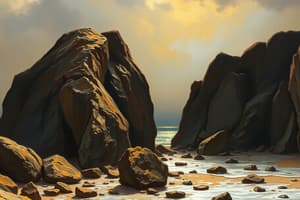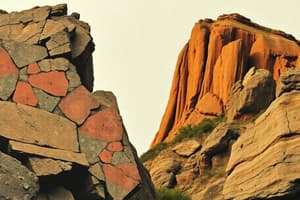Podcast
Questions and Answers
What does the rock cycle primarily explain?
What does the rock cycle primarily explain?
- The relationship between different rock types and their recycling processes. (correct)
- The movement of tectonic plates and their impact on rock formation.
- The process of soil formation.
- The formation of sedimentary layers.
Which of the following is a key component of the rock cycle?
Which of the following is a key component of the rock cycle?
- The continuous recycling of rocks through Earth's processes. (correct)
- The isolation of rocks in independent systems.
- The constant production of new minerals.
- The destruction of rocks through chemical reactions.
What is the primary driver of the rock cycle?
What is the primary driver of the rock cycle?
- The impact of plant and animal life on rock.
- The accumulation of sediments.
- The processes occurring within Earth. (correct)
- Weathering by air and water.
What aspect of the rock cycle highlights the interconnectedness of rock types?
What aspect of the rock cycle highlights the interconnectedness of rock types?
Why is the rock cycle considered a cycle?
Why is the rock cycle considered a cycle?
Flashcards
Rock Cycle
Rock Cycle
A continuous process where rocks transform from one type to another through geological events.
Igneous Rocks
Igneous Rocks
Rocks formed from the cooling and solidification of molten rock (magma or lava).
Sedimentary Rocks
Sedimentary Rocks
Rocks formed from the accumulation and cementation of sediments (fragments of other rocks).
Metamorphic Rocks
Metamorphic Rocks
Signup and view all the flashcards
Geological Processes
Geological Processes
Signup and view all the flashcards
Study Notes
The Rock Cycle
- The rock cycle is a fundamental concept in geology that illustrates the interconnectedness and continuous transformation of rocks on Earth.
- It explains how various types of rocks are formed and how they are related through different geological processes.
- The rock cycle demonstrates that rocks are not static entities but rather are constantly being recycled, changing from one type to another over immense periods of time.
- This continuous recycling is driven by various geological processes, such as weathering, erosion, deposition, metamorphism, and melting.
Types of Rocks
- The rock cycle encompasses three main rock types: igneous, sedimentary, and metamorphic.
- Igneous rocks are formed from the cooling and solidification of molten rock (magma or lava).
- Sedimentary rocks are formed through the accumulation and cementation of sediments, like sand, silt, and clay. This often involves processes like weathering, erosion, and transportation.
- Metamorphic rocks are formed from existing rocks that have been transformed by heat, pressure, or chemical reactions. This transformation can change their mineral composition and texture significantly.
Processes in the Rock Cycle
- Melting: High temperatures can melt rocks, turning them into magma or lava. This molten material can then cool and solidify, forming new igneous rocks.
- Cooling and Solidification: Magma or lava cools and solidifies, forming igneous rocks. This cooling can occur slowly beneath Earth's surface (forming intrusive igneous rocks) or quickly at the surface (forming extrusive igneous rocks).
- Weathering and Erosion: Exposure to elements like wind, water, and ice breaks down rocks into smaller pieces (sediments).
- Transportation: Moving water, wind, or ice carries these sediments to new locations.
- Deposition: Eventually, the sediments settle out of the transporting medium and are deposited in layers.
- Compaction and Cementation: Over time, more sediment accumulates on top of the layers, creating pressure. This pressure, combined with dissolved minerals, can cement the sediments together forming sedimentary rocks.
- Heat and Pressure (Metamorphism): Increased temperature and pressure deep within the Earth can transform existing rocks, changing their mineral composition and texture, forming metamorphic rocks. This can occur without melting the rock.
- Remelting: Intense heat can melt metamorphic rocks, leading back to magma, completing the cycle.
Interconnectedness of the Rock Cycle
- The processes of the rock cycle are interconnected. For example:
- Igneous rocks can be weathered and eroded into sediments, which can be compacted and cemented into sedimentary rocks.
- Sedimentary rocks can be buried to great depths, subjected to intense heat and pressure, turning them into metamorphic rocks.
- Metamorphic rocks can be exposed at the surface and weathered and eroded, eventually returning to sediments to begin the cycle once more.
- The cycling of rocks demonstrates the dynamic nature of Earth's surface and the continuous interaction between the different parts of the Earth system.
- The rates of these processes vary greatly, with some occurring quickly (sedimentation, erosion), while others are considerably slower (metamorphism, mountain building).
Studying That Suits You
Use AI to generate personalized quizzes and flashcards to suit your learning preferences.




